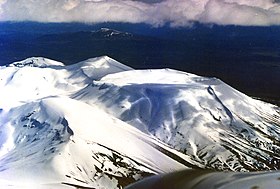Mount Tongariro (/ˈtÉ'ŋɡəˌrÉ›.roÊŠ/; MÄori pronunciation: [tÉ"Å‹aɾiɾÉ"]) is a compound volcano in the Taupo Volcanic Zone of the North Island of New Zealand. It is located 20 kilometres (12 mi) to the southwest of Lake Taupo, and is the northernmost of the three active volcanoes that dominate the landscape of the central North Island.
Geology

The volcanic massif, often referred to as simply Tongariro, has a height of 1,978 metres (6,490Â ft). It first erupted 275,000 years ago. The volcano consists of at least 12 cones. Ngauruhoe, while often regarded as a separate mountain, is geologically a cone of Tongariro. It is also the most active vent, having erupted more than 70 times since 1839, the last episode in 1973 to 1975.
Activity has also been recorded at other vents in recent history. Te MÄri Craters erupted in 2012, for the first time since 1897. Red Crater last erupted ash in 1926 and contains active fumaroles. There are many explosion craters on the massif; water has filled some of these to form the Blue Lake and the Emerald Lakes.
Andesitic eruptions tend to form steep stratovolcanoes with layers of both lava and tephra, including mountains such as Tongariro. The high altitude and severe alpine climate between March and October cause snowfall in the winter (there are commercial ski-fields at neighbouring Mount Ruapehu) and rain can freeze, causing verglas; in contrast in the mid to late summer, the mountains can be bare apart from remnant patches of snow in south-facing gullies.
History

Mount Tongariro is in the Tongariro National Park, New Zealand's first national park and one of the earliest in the world. It was set aside (literally "made sacred") in 1887 by Te Heuheu Tukino IV (Horonuku), paramount chief of the MÄori Ngati Tuwharetoa iwi and made a national park in order to preserve its natural beauty. The park also includes the peaks of Ngauruhoe and Ruapehu, both of which lie to the southwest of Tongariro. The national park is a dual World Heritage Site for its outstanding natural and intangible cultural values.
The popular hiking route called Tongariro Alpine Crossing passes between Tongariro and Ngauruhoe.
Mount Tongariro and its surroundings are also one of the several locations which Peter Jackson chose to shoot the The Lord of the Rings film trilogy.
2012 Te MÄri eruptions
At 11:50Â pm (NZST, UTC+12) on 6 August 2012, Mt Tongariro had what was initially believed to be a hydrothermal eruption after a month of increased activity. The eruption occurred at the Te MÄri Craters, which had been dormant since 1897.
The eruption occurred in a new vent below the Upper Te MÄri crater, and sent blocks as big as 1 metre (3Â ft 3Â in) in size up to 2 kilometres (1.2Â mi) from the vent.
An ash cloud 6.1 kilometres (3.8 mi) high deposited ash into the surrounding area, especially to the east of the volcano. The ash cloud travelled 250 kilometres (160 mi) in four hours. NIWA reported the ash cloud contained about 10,000 cubic metres (350,000 cu ft) of ash, and that the ash cloud was 25 kilometres (16 mi) long and 15 kilometres (9.3 mi) wide 39 minutes after the eruption. Ash and the smell of sulphur was reported in Napier and Hastings. The smell of sulphur was also reported in Wellington, Nelson and Blenheim.
State Highway 1 to the east and State Highway 46 to the north of the mountain each received up to 5 centimetres (2.0 in) of ash cover, and were closed until the following morning due to ash and low visibility. A layer of ash 10â€"15 mm thick settled on farmland 5 to 10 kilometres (3.1 to 6.2 mi) east of Mount Tongariro. Particle sizes were between 2 and 3mm. The airspace within a 12 kilometres (7.5 mi) radius of the mountain was closed after the eruption, but later reopened to visual flights only. Air New Zealand cancelled some flights in and out of Rotorua, Taupo, Gisborne, Napier, Wanganui and Palmerston North due to the risk of volcanic ash clogging the engines on their aircraft serving those airports.
No injuries were reported, and the only significant property damage was to the Department of Conservation's Ketetahi Hut, which is located 1.5 kilometres (0.93Â mi) west of the Te MÄri Craters. There was no official evacuation but 24 people living along State Highway 46 fled their homes for fear of being isolated.
Mount Tongariro erupted again at 1:20pm on 21 November, ejecting an ash cloud 4000 metres into the air. Flights in the area were cancelled, as were several the following morning. Geologists had no warning before the eruption, saying it wasn't linked to warnings the week before of elevated activity at nearby Mount Ruapehu.
See also

- List of mountains of New Zealand by height
- Volcanism of New Zealand
- List of volcanoes in New Zealand
- Tongariro Northern Circuit
References
Further reading
- Hill, H. (1893) The Volcanic Outburst at Te MÄri, Tongariro, in November, 1892., Transactions of the New Zealand Institute, 26, 388-391.
External links
- Tongariro National Park at the Department of Conservation
- Tongariro Alpine Crossing at the Department of Conservation
- Tongariro Alpine Crossing photos at Virtual Oceania

Posting Komentar